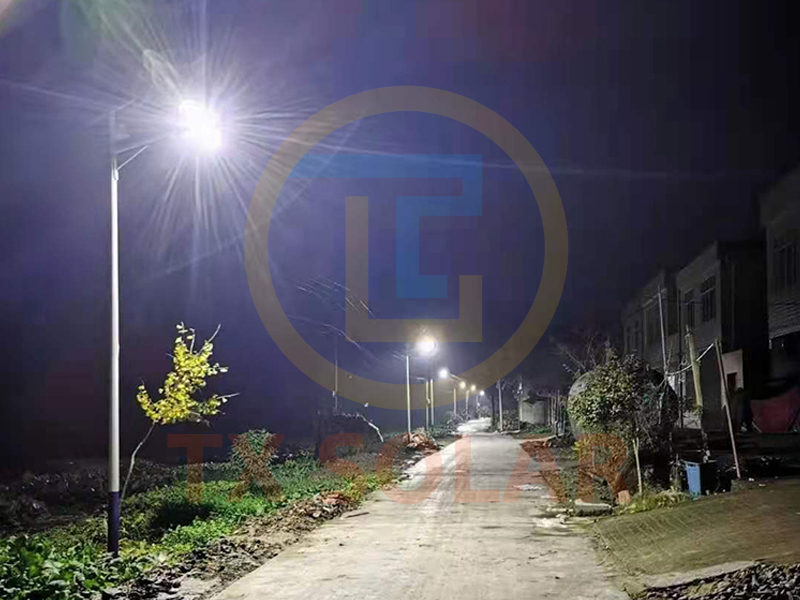The adoption of solar energy has gained momentum in recent years, especially in rural areas with limited access to electricity. One of the most effective applications of solar technology in villages is the installation of solar street lights. These lights not only enhance safety and security but also promote sustainable living. However, the effectiveness of solar street lights depends largely on their correct placement. In this article, we’ll explore how to position village solar street lights for optimal performance and community benefits.
Learn about solar street lights
Before diving into the installation process, it is necessary to understand what solar street lights are. The lights are equipped with solar panels that convert sunlight into electricity, which is then stored in batteries for use at night. They usually consist of three main components: solar panels, LED light fixtures, and batteries. Since there is no wiring, they are ideal for villages where infrastructure is lacking.
Benefits of village solar street lights
1. Cost Effectiveness: Solar street lights rely on renewable energy and therefore can reduce electricity costs.
2. Eco-Friendly: They help reduce carbon footprint and promote sustainable energy use.
3. Easy to install: No need for a lot of wiring, installation is simple and can be completed quickly.
4. Improved Safety: Well-lit streets deter crime and increase safety for pedestrians and vehicles.
Factors to consider when arranging solar street lights
1. Assessment Area
Before placing solar street lights, conduct a thorough assessment of the village area. Identify key locations that require lighting, such as:
- Main roads
- Access to schools, hospitals and community centers
- Parks and recreation areas
- Crossroads with heavy traffic
2. Determine the Light Spacing
The spacing between solar street lights is crucial to ensure adequate lighting. Generally speaking, the distance between lights can be anywhere from 100 to 150 feet, depending on the brightness of the LED fixture and the specific lighting needs of the area. For example, areas with higher foot traffic may require closer spacing to ensure safety.
3. Direction and Angle of Solar Panels
The orientation of solar panels is critical to maximizing sunlight exposure. Ideally, panels should face south (in the Northern Hemisphere) or north (in the Southern Hemisphere) to capture the most sunlight throughout the day. Additionally, the angle of the panels should be adjusted based on geographical location to optimize solar gain.
4. Lamp Height
The installation height of solar street lights will significantly affect their effectiveness. Generally speaking, the recommended street lighting height is 10 to 15 feet. This height ensures even light distribution while minimizing glare for drivers and pedestrians.
5. Community Opinion
Involving the community in the planning process is critical. Residents can provide valuable insight into areas that need lighting and can help identify potential safety issues. Organizing community meetings or surveys can facilitate this process and ensure that the placement of solar street lights meets the needs of villagers.
6. Maintenance Precautions
Although solar street lights require less maintenance than traditional street lights, it is still important to consider accessibility to maintenance. Make sure the lights are arranged in a way that allows easy access to the solar panels and batteries for cleaning and maintenance.
Implementation steps
Once you’ve assessed the area and determined the best placement of solar street lights, follow these steps to implement it:
1. Choose the right equipment: Choose high-quality solar street lights that suit the specific needs of your village. Consider factors like brightness, battery capacity, and durability.
2. Plan Layout: Create a detailed layout plan including the location of each light, solar panel spacing and orientation.
3. Installing Lights: Begin the installation process by making sure each light is securely mounted and the solar panels are oriented correctly.
4. Test the System: After installation, test the lights to make sure they are working properly and providing adequate lighting.
5. Educate the Community: Inform villagers about the benefits of solar street lights and how to report any problems that may arise.
In conclusion
Arranging village solar street lights is a multi-faceted process that requires careful planning and consideration. By assessing areas, determining appropriate spacing and engaging the community, villages can create a light-filled environment that enhances safety and promotes sustainable living. As more communities adopt solar technology, the benefits of solar street lights will continue to light the way to a brighter, greener future.
Post time: Oct-17-2024

